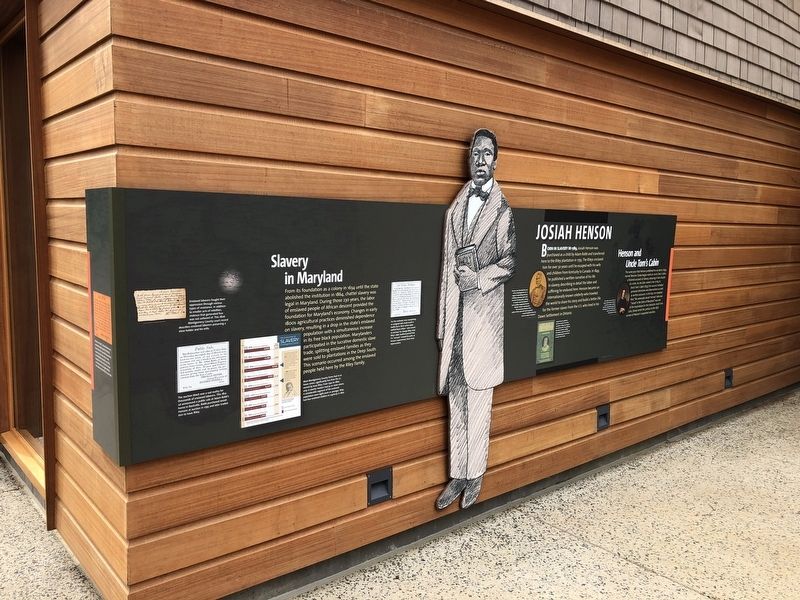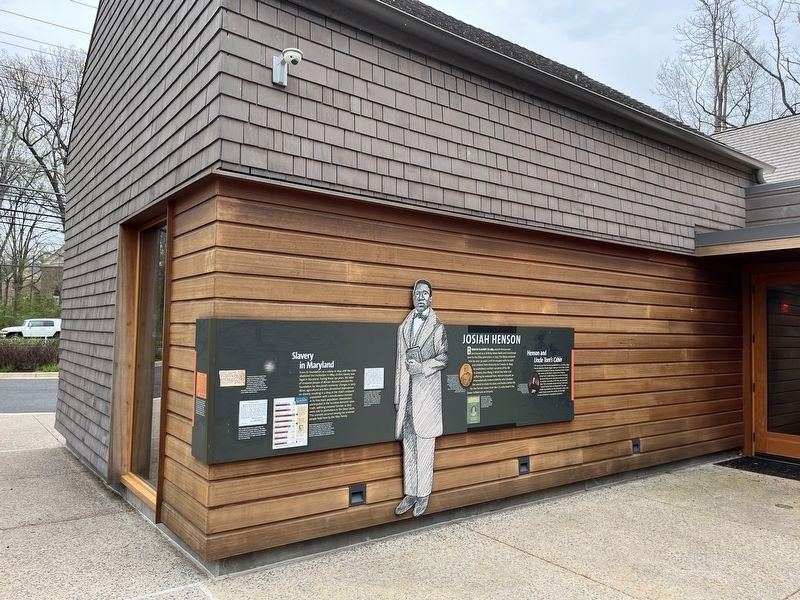North Bethesda in Montgomery County, Maryland — The American Northeast (Mid-Atlantic)
Josiah Henson
Born into slavery in 1789, Josiah Henson was purchased as a child by Adam Robb and transferred here to the Riley plantation in 1795. The Rileys enslaved him for over 30 years until he escaped with his wife and children from Kentucky to Canada. In 1849, he published a written narrative of his life in slavery, describing in detail the labor and suffering endured here. Henson became an internationally known celebrity who traveled the world to share his story and build a better life for the former slaves from the U.S. who lived in his Dawn Settlement in Ontario.
Henson and Uncle Tom's Cabin
The same year that Henson published his narrative, 1849, Harriet Beecher Stowe began work on Uncle Tom's Cabin, a fictional account of slavery, releasing it one chapter at a time. As she later noted in her A Key to Uncle Tom's Cabin (1853), her sources included personal interviews and observations as well as written accounts. In the Key, she revealed that "the venerable Josiah Henson" who was "'raised' in the State of Maryland" was one of the inspirations for the character Uncle Tom. Later, Stowe wrote the preface to the 1858 version of Henson's expanded narrative.
[Sidebar:]
Slavery in Maryland
From its foundation as a colony in 1634 until the state abolished the institution in 1864, chattel slavery was legal in Maryland. During those 230 years, the labor of enslaved people of African descent provided the foundation for Maryland's economy. Changes in early 1800s agricultural practices diminished dependence on slavery, resulting in a drop in the state's enslaved population. Marylanders participated in the lucrative domestic slave trade, splitting enslaved families as they ere sold to plantations in the Deep South. This scenario occurred among the enslaved people held here by the Riley family.
[Captions:]
Defined as "chattel," enslaved laborers were considered valuable property. Protecting these assets often meant offering monetary rewards to return those who ran away. Samuel Middleton placed this ad in 1814, hoping for the return of Charles to ensure an inheritance for his daughter Matilda. She would marry Isaac Riley four years later.
Enslaved laborers fought their oppression through various types of resistance. In addition to smaller acts of rebellion, violence that generated fear was not unheard of. This 1806 Montgomery County court record describes enslaved laborers poisoning a slave holder and his wife.
The auction block was a sad reality for thousands of enslaved laborers. This 1810 ad announced a public sale at Adam Robb's home in Rockville. Robb purchased Josiah Henson at
The Evolution of Slavery in Montgomery County
• 1790: 879 owners, avg. 7 slaves each; 6,030 [total enslaved people]; total county population 18,003
• 1800: 864 owners, avg. 7 slaves each; 6,288 [total enslaved people]; total county population 15,058
• 1810: 934 owners; avg. 9 slaves each; 50% under the age of 14 8,056 [total enslaved people]; total county population 17,980
⯇ Following the end of the Atlantic Slave Trade in 1808, a heavier reliance on enslaved families to replenish the labor supply meant a substantial percentage of enslaved people were, in fact, children.
• 1820: 522 owners, avg. 13 slaves each; 50% under the age of 14 6,936 [total enslaved people]; total county population 16,400
⯇ In 1825, Josiah Henson recalled there were 22 enslaved people including 2 of his own children, at the Riley plantation.
• 1830: 830 owners, avg. 7 slaves each; 47% under the age of 14 6,447 [total enslaved people]; total county population 19,816
• 1840: 1,124 owners, avg. 5 slaves each; 47% under the age of 10 5,377 [total enslaved people]; total county population 15,456
• 1850: 837 owners, avg. 6 slaves each; 45% under the age of 14 5,114[total enslaved people]; total county population 15,860
• 1860: 762 owners, avg. 6 slaves each; 44% under the age of 14 4,903 [total enslaved people]; total county population 18,322
Most Montgomery County farms had 10 or fewer slaves, significantly less than the 22 owned by Isaac Riley. From 1790 to 1860, only 17 county masters had 50 or more slaves. A considerable segment of the enslaved population were eight years or younger. Riley had four enslaved children in captivity in 1820.
For the enslaved, even completing an assigned task could result in bodily hard. Brice Letton (also spelled Bryce Litton — who served as overseer for George Riley, Isaac Riley's older brother) proved that if a "servant" crossed his path, as Henson experienced, there were repercussions.
Henson was described by one of his contemporaries as "a negro of unyielding tenacity, unfailing resources, quick wit, and also a deep piety... strong in muscle and constitution." Such qualities supported Harriet Beecher Stowe's assessment: "the numerous friends of the author of this work will need no greater recommendation than his name to make it welcome."
Josiah Henson published the first version of his slave narrative in 1849, covering his life to that point. He published four later versions, adding information about his later life and addressing his connection to Uncle Tom's Cabin.
The author of more than 30 books, Harriet Beecher Stowe secured her place in history with her widespread popularity and impact of Uncle Tom's Cabin, which turned American minds against slavery.
Erected 2021 by Montgomery Parks.
Topics. This historical marker is listed in these topic lists: Abolition & Underground RR • African Americans • Agriculture • Arts, Letters, Music. A significant historical year for this entry is 1789.
Location. 39° 2.619′ N, 77° 7.295′ W. Marker is in North Bethesda, Maryland, in Montgomery County. Marker is on Old Georgetown Road (Maryland Route 187) 0.1 miles south of Tilden Lane, on the right when traveling south. Touch for map. Marker is at or near this postal address: 11420 Old Georgetown Rd, Rockville MD 20852, United States of America. Touch for directions.
Other nearby markers. At least 8 other markers are within walking distance of this marker. The Riley Plantation (a few steps from this marker); A Royal Audience (within shouting distance of this marker); Return to the Riley Farm (within shouting distance of this marker); Whose House Was This? (within shouting distance of this marker); Life in the Slave Quarters (within shouting distance of this marker); Agriculture on the Riley Plantation (within shouting distance of this marker); The Meathouse: A Food Vault (within shouting distance of this marker); Archaeology at Josiah Henson Park (within shouting distance of this marker). Touch for a list and map of all markers in North Bethesda.
Additional keywords. human trafficking; slave labor; child slavery
Credits. This page was last revised on April 7, 2023. It was originally submitted on June 4, 2021, by Devry Becker Jones of Washington, District of Columbia. This page has been viewed 254 times since then and 24 times this year. Last updated on January 5, 2022, by Bruce Guthrie of Silver Spring, Maryland. Photos: 1. submitted on June 4, 2021, by Devry Becker Jones of Washington, District of Columbia. 2. submitted on April 7, 2023, by Devry Becker Jones of Washington, District of Columbia.

